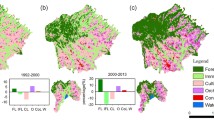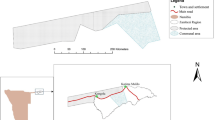Abstract
The landscape of central Arizona U.S.A. is characterized by a patchy distribution of three major vegetation types: chaparral, woodland and grassland. Disturbance is common in the landscape, primarily livestock grazing, fire and conversion (i.e., removal of woody plants to increase forage for livestock). The purposes of this research were to determine changes in the landscape mosaic of central Arizona between 1940 and 1989 and to predict future changes. Using aerial photographs from 1940, 1968 and 1989 and digital overlays followed by transition matrix analysis, we found that chaparral and its adjacent grassland had changed less than woodland and its grassland. However, both had nearly equal projected stabilization times. Moreover, disturbance increased time for stabilization and some results were scale-dependent.
Similar content being viewed by others
References
Aaviksoo, Kiira. 1993. Changes of plant cover and land use types (1950's to 1980's) in three mire reserves and their neighborhood in Estonia. Landscape Ecol. 8: 287-301.
Bahre, C. J. 1991.Legacy of change: historic human impact on vegetation in the Arizona Borderlands. University of Arizona Press, Tucson.
Bahre, C. J. & Shelton, M. L. 1993. Historic vegetation change, mesquite increases, and climate in southeastern Arizona. Journal of Biogeography 20: 489-504.
Barnes, W. C. 1935. Arizona place names. University of Arizona General Bulletin 2. Borlander, D.H. 1982. Chaparral in Arizona. Pp. 60-63. In: Eugene, C. C. and Oechel, W. C. (eds), Proceedings of a Symposium: Dynamics and Management of Mediterranean-type Ecosystems. General Technical Report PSW-58, USDA, Pacific Southwest Experiment Station.
Borse, G. J. 1985. FORTRAN 77 and Numerical Methods for Engineers. PWS-Kent Publishing Company, Boston. pp. 396-428.
Cable, D. R. 1975. Range management in the chaparral type and its ecological basis: the status of our knowledge. USDA Forest Service Research Paper RM-155, Rocky Mtn Forest and Range Experiment Station.
Carmichael, R. S., Knipe, O. D., Pase, C.P. & Brady, W. W. 1978. Arizona Chaparral: Plant Associations and Ecology. USDA Research Paper RM-202, Rocky Mtn. Forest and Range Station.
Croxen, F. W. 1926. History of grazing Tonto. Tonto Grazing Conference. Phoenix, Arizona.
Davis, O. K. & Turner, R.M. 1986. Palynological evidence for the historic expansion of juniper and desert shrubs in Arizona, U.S.A. Rev. Palaeobotany Palynology 49: 177-193.
Davis, O. K., Hevly R. H. and Foust, R. D., Jr. 1985. A comparison of historic and prehistoric vegetation change caused by man in central Arizona. AASP Contribution Series No 16: 63-76.
Delcourt, H. R., Delcourt, P. A. and Webb, T. III. 1983. Dynamic plant ecology: the spectrum of vegetational change in space and time. Quat. Sci. Rev. 1: 153-175.
Eastman, J. R. 1993. IDRISI version 4.1. Graduate School of Geography, Clark University. Worcester, Massachusetts.
Evans, R. A. 1988. Management of Pinyon-Juniper Woodlands. USDA Intermountain Research Station, General Technical Report INT-249.
Gould, F. W. 1988. Grasses of the Southwestern United States. The University of Arizona Press, Tucson, AZ, pp.9-20.
Hastings, J. R. & Turner, R.M. 1965. The changing mile: an ecological study of vegetation change with time in the lower mile of an arid and semiarid region. University of Arizona Press, Tucson.
Huebner, C. D. 1996. Effects of disturbance and environment on the chaparral-woodland-grassland landscape mosaic of central Arizona. A Dissertation. Miami University. Oxford, OH.
Kearney, T. H. & Peebles, R. H. 1960. Arizona Flora. University of California Press, Berkeley California, USA.
Lowe, C. H. 1977. Arizona's natural environment. The University of Arizona, Tucson, Pp. 15-84.
Meentemeyer, V. &Box, E. O. 1987. Scale effects in landscape studies. Pp. 14-34. In: Turner, M. G. (ed.), Landscape heterogeneity and disturbance-Ecological Studies 64. Springer-Verlag, New York.
Miller, R. F. & Wigand, P.E. 1994. Holocene changes in semiarid pinyon-juniper woodlands. BioScience 44: 465-474.
Moler, 1981. MATLAB User's Guide. University of New Mexico, Albuquerque.
Spang, E. F. 1987. Juniper from a Bureau of Land Management Perspective. Pp. 489-493. In: Everett, R. L. (ed.), Proceedings of the Pinyon-Juniper Conference. USDA General Technical Report T-215.
Strategic Mapping, Inc. 1992. Atlas GIS and Draw.
Usher, M. B. 1984. Modelling successional processes in ecosystems. Pp. 31-56, In: Gray, A.J, Crawley, M. J. and Edwards, P. J. (eds), Colonization, succession and stability. Blackwell Scientific Publications, Oxford, U.K.
Wright, H. A. 1990. Role of fire in the management of southwestern ecosystems. Pp. 1-5. In: Effects of Fire Management of Southwestern Natural Resources, General Technical Report RM-191, USDA Forest Service.
Young, C. W. 1995. IMAP version 2. Geography Department, Miami University. Oxford, Ohio.
Author information
Authors and Affiliations
Rights and permissions
About this article
Cite this article
Huebner, C.D., Vankat, J.L. & Renwick, W.H. Change in the vegetation mosaic of central Arizona USA between 1940 and 1989. Plant Ecology 144, 83–91 (1999). https://doi.org/10.1023/A:1009892126986
Issue Date:
DOI: https://doi.org/10.1023/A:1009892126986




